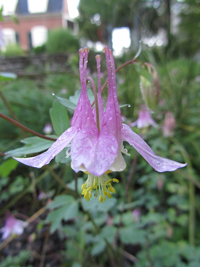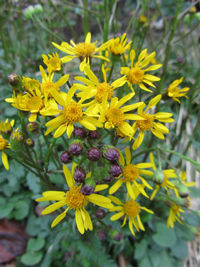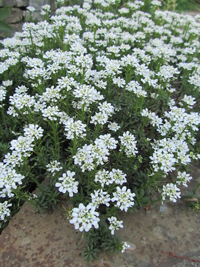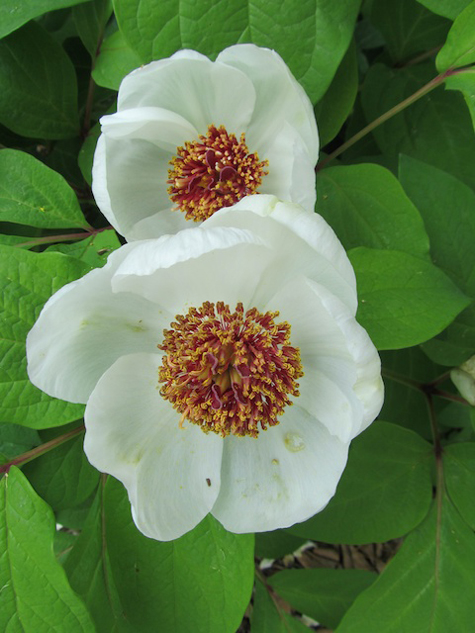Human Flower Project
Floral Trophies
Louisville was spared deadly weather but still broke records this spring with warm temperatures. Allen Bush shares the trophies.
 Aquilegia canadensis ‘Pink lanterns
Aquilegia canadensis ‘Pink lanterns
Photo: Allen Bush
By Allen Bush
It’s been a record-breaking late winter and early spring in Kentucky. A tornado, the deadliest to hit the Ohio Valley since 1974, clobbered Henryville, Indiana. We spent a couple of hours in the basement on March 2nd under tornado watch but were spared the eight twisters that churned a path from southern Indiana to eastern Kentucky. These storms, with violent winds and hail the size of soft balls, put everyone on edge. But we got off easy.
The other fixation was University of Kentucky’s 8th collegiate basketball championship. Though record-breaking weather never gets a trophy presentation, it’s big news when the weather veers toward extremes. In Louisville this March, the prize went neither to tornadoes nor hail but to much warmer weather.
Instead of daytime temperatures in the 50s and 60s, we had nine days with summer-like heat in the 80s. You had to hold onto your hat to keep-up with the flurry of blooms. There hasn’t been a trace of frost since March 10th. The luscious blooms of Asian saucer and star Magnolias usually turn brown when they are routinely hit by a March freeze, but not this year, nor for the last three years, which must be a record. They were stunning this spring but had to hurry through flowering to make way for the rest of the floral parade.
 Senecio aureus/golden ragwort
Senecio aureus/golden ragwort
Photo: Allen Bush
Early March was a jump-start. I hurriedly did garden clean up to get onto fun chores. I divided and shuffled some Primulas to a few new spots. They struggled a bit in the heat but bounced back—the same with Trachystemon orientalis, and it never sulked. The heart shaped, dark green foliage never looks tattered, even deep into August. It withstands magnificently the punishment of dry shade. The blue-purple blooms, with a touch of white, looked good together in late March with the yellow flowering Senecio aureus that makes thick colonizing carpets nearby in partial shade.
I seldom sow seeds in pots anymore; they go directly into the garden. It’s so much simpler. Sowing in pots requires precision and attentiveness, and I’m too sloppy and forgetful. The new fig-leaf hollyhocks came-up within a week of the March sowing. Maybe it was a lucky roll of the dice with the new ‘Las Vegas’ seed strain. On the other hand, the wild collected prairie species from Missouri’s Shaw Arboretum are still sitting there. They may need a bit more cold to trigger germination. This didn’t happen in March and it won’t happen in April.
 Iberis ‘Little Gem’/low-growing candytuft
Iberis ‘Little Gem’/low-growing candytuft
Photo: Allen Bush
New gardeners, always eager for quick results, expect all sown seeds from lilies to lima beans to germinate in the short time it takes to whip through a single Sunday night episode of Downton Abbey. Many seeds aren’t so hasty. This year’s outdoor March-sown perennial and wildflower seeds may have to wait on germination until Maggie Smith rolls her eyes with aristocratic displeasure again next season.
There was no dawdling in the garden. The rare wild Chinese peony species, Paeonia obovata ssp. obovata var. willmottiae, was weeks ahead of any other garden peonies and lingered longer. Temperatures cooled down and rain didn’t pummel the sculpted white blooms.

Paeonia obovata ssp. obovata var. willmottiae, weeks ahead of the peony competition
Photo: Allen Bush
‘Corbett’ is hands down my favorite columbine, but ‘Pink Lanterns’ is giving it a run for the money in early April. Both are selections of the Canada columbine, Aquilegia canadensis that I find to be, hands down, the most agreeable species for the Ohio Valley. The pale yellow flowering ‘Corbett’ was found near the town of Corbett, Maryland, and has seeded around our garden for 15 years without ever becoming a nuisance. Its bloom time coincides with blue flowering Phlox subulatas and white flowering candytufts. ‘Pink Lanterns’ (18”/ 45 cm) is half again taller than ‘Corbett’. I almost rid the garden of them last year, but I’ve been won over this season. There’s a good chance ‘Pink Lanterns’ might cross with ‘Corbett.’ I won’t disrupt any backyard bacchanal.
 Duck(s) voguing and crossvine in bloom, Louisville, KY
Duck(s) voguing and crossvine in bloom, Louisville, KY
Photo: Allen Bush
The normal spring procession in Kentucky’s woodlands is the serviceberries, red buds, followed by dogwoods. One follows the other each week, depending on the season, from late March into mid-April and sometimes later. Typically, by mid-April, dogwoods are a lovely sight. You see the white flowers lighting-up the forest’s understory before the canopy leafs out. Before this year, I can’t ever recall dogwood blooms in March. Lots of folks imagine them flowering on Derby Day, the first Saturday in May, but that’s not likely either. (They did hang on until Derby on May 3rd four years ago following a cool April)
Streamside bluebells were still flowering on April Fools Day at the Mill on Wolf Pen Branch. Toothworts were finished along the hillsides but the little blue flowering Delphinium tricorne was up next in the parade. (On neither the toothwort nor the little Delphinium am I ever able to find seeds when I return a few weeks later. I’m always a day or two late.) Paw paws and Ohio Buckeyes were in flower, too. The blooms on a swamp white oak hung like dirty blonde tassels.
 Chionanthus pygmaeus/pygmy fringe tree
Chionanthus pygmaeus/pygmy fringe tree
Photo: Allen Bush
Rose has been agonizing all winter about the huge hole that was left when we took down the huge green ash in the front yard. (Ok, I had the tree taken down and took the blame.) It did look bare. Mary Vaananen, my Jelitto Perennial Seeds colleague is an artist and ace designer, and she came to the rescue with a great plan. The huge stump got ground to pulp and some soil was brought in. Ornamental grasses got planted the hard way – chipping away at old lateral tree roots with a pickaxe.
The rare and not so pygmy fringe tree, Chionanthus pygmaeus, native to only a few counties in central Florida, has never flowered so well in our Kentucky garden as it did beginning on April 5th. The tree was a wedding present 17 years ago and has endured ups and downs. It got cut back to the ground five years ago in the hard freezes of early April when, after a warm March, the temperatures dipped into the high teens and stayed below freezing for nearly four days. (Memo to self: Don’t let this happen again!) The pygmy fringe tree, multi-stemmed, is now about 8’ tall. This spring it was bent over from the heavy weight of the blooms. I dutifully staked the Florida native.
The tree has been a federally designated endangered species since 1987; the marriage, licensed by Kentucky in 1995, remains strong.
Comments
Georgia, we’ve got a dry spell going on now. Only a 1/4” of rain this month. I can’t remember dragging hoses around so early. What happened to April showers?
Every time it’s supposed to rain here it does not.


I am really enjoying the warm weather but also am perturbed by its unseasonable nature. Lots of blooms here in NYC, too.